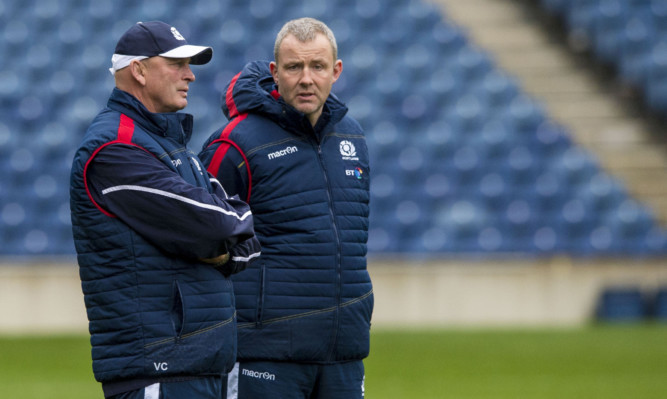Pragmatism, or a bit of a backward step?
Scotland still think they have the team to beat Ireland and win a third successive RBS 6 Nations game for the first time, but the boldness of recent weeks seems to have been blunted in the selection for tomorrow in Dublin.
Vern Cotter has changed a winning team again, recalling Duncan Weir, Tim Swinson and Ryan Wilson. Two of those changes are technically enforced, with Finn Russell still under concussion watch and Jonny Gray suffering a tear in a pectoral muscle.
Weir being preferred at 10 to Peter Horne, who led the line so seamlessly in emergency against France, is not an enormous surprise but unquestionably a conservative choice.
For all that Weir is certainly a more practised stand-off and more of a rounded player than he was, Horne’s performance on Sunday suggested strongly that the former Howe of Fife player’s considerable talents are wasted as bench cover.
Swinson for Gray is no shock either, although had Grant Gilchrist been fit one would be a bit more comfortable with the indefatigable 22-year-old’s absence. it’s a tall order for Swinson, despite his attributes, to match Gray’s incredible tackle efficiency and phenomenal workrate.
Wilson being preferred to Josh Strauss at No 8 is another puzzler, not that we don’t all realise the abrasive Glasgow back rower is clearly a favourite of Cotter and Jon Humphreys, but without Gray’s 10 to 11 carries a game, putting Strauss back on the bench leaves Scotland a little short of go-forward muscle.
Using Ross Ford in the ball-carrying role has not entirely been successful as the veteran hooker tends to get a bit upright which Ireland’s legion of choke tacklers and ball stealers will love.
Cotter’s view is that we shouldn’t get ahead of ourselves, and treat every game in isolation. And he’s also conscious of the very short turnaround, mentioning that the team were “still down on energy” after Sunday’s efforts.
He expects that to be better by today and has full confidence in Weir, clearly.
“Duncan’s development has all come from him,” he said. “It is his desire to do well and improve his game, which is great. As coaches, having players who are motivated in that manner is always really good.
“I think he has improved all over. He has such a great positive attitude to the game and a positive attitude to change and development. It’s a credit to him.”
Horne, he added, was more of a “12 stroke 10 than a 10 stroke 12”, although he had “come on so much in the last 12 months.
“We’re hoping that if he gets the call he’ll have the same effect as he did on Sunday at 10, 12 or 13,” he added.
Weir is certainly fresher, and that seems to have been the prime reasoning behind bringing in Wilson for Strauss.
Italy may have been there for the taking last week, but Cotter believes that Ireland’s performance in scoring a half century has to be respected, and is certainly wary of the view that the Irish may be in rebuild under his old friend Joe Schmidt.
“I think it has been fine margins this season for them,” he continued. “Putting the number of points they did against Italy shows they are capable of playing very well.
“They are a big, young, bulky team. Irish rugby has always been physical and I think with Jonny Sexton and Conor Murray running the show they have that core in how the team is directed.
“It will be a game played with a lot of intensity, as it always is, so we will have to get our heads up and stay smart and try to apply pressure as long as we can and get results from that.”
For Scotland, two aspects have manifestly changed this season from being the most penalised team in the 6 Nations the last two seasons, they are presently the least penalised, and an average of just under 30 points scored in the last three games suggests they have real offensive threat these days.
“It’s a team effort, or all the polayers and all the coaches,” he said. “But as a group we do focus on discipline, I think the team is taking pride in that.
“You don’t want to give the opposition easy opportunities to get lineouts in your half. These things always seem to be tied closely to penalty counts.
“Away from home you have to be very disciplined and give no easy access to the opposition. It is one of the things the group is focusing on and I think they’re doing a good job.”
Team: S Hogg (Glasgow); T Seymour (Glasgow), D Taylor (Saracens), A Dunbar (Glasgow), T Visser (Harlequins); D Weir (Glasgow), G Laidlaw (Gloucester, capt); A Dickinson, R Ford, W P Nel (all Edinburgh); T Swinson (Glasgow), R Gray (Castres); J Barclay (Scarlets), J Hardie (Edinburgh), R Wilson (Glasgow).
Replacements: S McInally (Edinburgh), R Sutherland (Edinburgh), M Low (Exeter), R Harley (Glasgow), J Strauss (Glasgow), H Pyrgos (Glasgow), P Horne (Glasgow), S Lamont (Glasgow).
